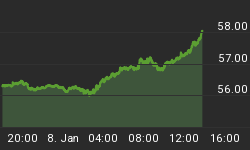The good news is:
• The number of new lows remains insignificant.
• The secondaries have held up well relative to the blue chips.
Friday's market activity was troublesome. Many of the short term indicators appeared to bottom with Monday's low and were heading upward until Friday.
The chart below makes the point. The chart shows a 10% trend of New lows calculated over the past 6 weeks (rather than 52 weeks as reported by the exchanges) of only the issues in the S&P 500. The indicator is plotted on an inverted Y axis so an increasing number of new lows moves the indicator downward. There was a low for the past year on Monday and the indicator was heading upward until Friday.

This reminded me of patterns seen in July-August of 1990 when new lows continued to build during the rallies following the mid-July high...
The chart below shows a 10% trend of NYSE new highs (52 week) in green and a 10% trend on NYSE new lows on an inverted Y axis in blue, the Dow Jones Industrial Average is shown in red.

I got a reality check looking at a chart of the current period using the same parameters.. In the first chart the new high indicator was off a high made a year earlier and the value of the EMA of new lows was 117. In the next chart the new low indicator is barely off the top of the chart and the value of the indicator is 9. In the first chart the value of the new high indicator was 24 while the current value of the new high indicator is 177. Even considering the caveat that NYSE new high and new low data is not what it used to be, there should be no confusing the current period with 1990.

Longer term I remain optimistic, next week is a different matter. The deterioration Friday was widespread, the chart below shows the difference of momentum of volume of issues of the S&P 500 moving down subtracted from momentum of volume of issues moving up. The indicator has made rapid reversals several times in the past 6 months, but usually a turn downward has indicated the beginning of a weak period lasting a week or two.

The next chart shows momentum of total volume of the issues in the Russell 2000 (R2K). The best performance is usually realized while the indicator is rising. The indicator lags, but the current posture of sharp decline is not encouraging.

The last chart shows 3 indicators along with the NASDAQ composite. Thei indicators are summation indexes (SI) of oscillators of NASDAQ advances and declines, new highs and new lows and upside and downside volume. They vary somewhat, but when they are all heading in the same direction it is imprudent to bet against them and they are all heading downward. A chart made from NYSE data looks similar.

It is a little early to say, but my expectation for a low early last week was probably wrong.
I expect another leg downward and the major indices will be lower on Friday March 26 than they were on Friday March 19.
















